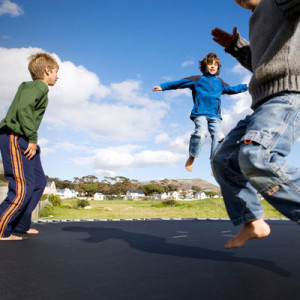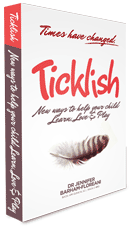 Our eleven year-old is a trampoline enthusiast. He would literally take a trampolining class every day if the family budget would allow…
Our eleven year-old is a trampoline enthusiast. He would literally take a trampolining class every day if the family budget would allow…
He loves how his chest is becoming stronger and his shoulders and arms muscle-bound, but as chiropractic parents we feel a little uneasy about his eagerness to bounce and flip from the moment he wakes. Yesterday he took a nasty fall trying to perfect a standing back-sault and experienced for the first time a whiplash injury. He was rather distressed by the acute pain and the headaches that followed that evening. The experience helped him appreciate how the body gives us signs and symptoms when it is distressed.
Just like adults, children can become ‘out of sorts’ and end up with headaches due to knocks or falls, poor diet, a lack of sleep or a lack of water etc. Interestingly, they are also susceptible to stress particularly when it relates to family matters—one such presentation for stress even in children may be headaches or abdominal migraines.
Headaches are a common problem for adults however they also affect a large number of children. A 2006 study reported that over 3.7 million American children between the ages of 4 and 17 experienced headaches in the previous 12 months (1). A study of Australian children found that only 36.8% of 10-18 year olds had never experienced a headache (2). Headaches are in fact one of the top 5 health problems experienced by children (3).
1. Should parents worry about their child’s headache?
Any headache in a child should be discussed with a health practitioner. It is possible for headaches in children to be caused by serious underlying conditions, this is rare however and there are generally other highly concerning signs and symptoms such as paralysis, drowsiness or loss of consciousness that are also evident (3). A new headache that is progressively worsening over days to weeks, or a persistent one-sided headache are both cause for concern and parents should seek advice from their health care provider(3). Most commonly however, childhood headaches are tension-type and migraine, and in 60% of cases they run in the family (1,4). Aside from pain and discomfort, childhood headaches can lead to missed days at school, poor school performance and emotional difficulties (4).
2. What symptoms do children with migraine or tension headaches experience?
Children that are too young to verbalise their pain may instead grab or hold their face, hit their head against the floor, show sensitivity to light or be disinterested in food (5). Infants may display ineffective latching, grimacing or positional discomfort when feeding from the breast or a bottle (5).
Parents who are aware that their child suffers from migraine can sometimes predict when a migraine is about to start. Their child may become lethargic, have mood changes, yawn excessively, crave food or become thirsty, or turn pale with dark circles under the eyes (4). Migraine does not always involve headache but can instead manifest as episodes of abdominal pain, cyclical vomiting or dizziness, and children with migraine often seek refuge in a quiet and darkened bedroom (4). Tension-type headaches tend to occur frequently (daily or several times per week), can be associated with stress at home or at school and are more common in anxious or highly emotional children (1).
3. What are potential causes of childhood headaches?
Headaches can be due to a number of environmental factors and may also have genetic links. A significant finding in a chiropractic study of thirteen cases found that birth trauma and assisted birth (forceps, ventouse extraction or caesarean) were associated with each case of headache (5). In this study all children demonstrated significant dysfunction of the upper neck joints and musculature. The authors stated: “The forces exerted upon the cervical spine during assisted deliveries would likely be sufficient to cause muscular and mechanical joint impairments considering the increased laxity of the infant spine”. Please not this may not be the case with all forceps deliveries.
Another important point is that along with damage or irritation of the neck region, the birth process may at times also lead to jaw problems in infants that are particularly painful when trying to latch and breastfeed. Interestingly, jaw problems and headache often overlap in adults (5).
4. What types of care are available?
Many parents will give medication to a child who has a headache, as this is what they might do for their own pain. However, studies that specifically look at the safety and effectiveness of medication for children are very limited (3). A number of medications are shown to have serious side-effects in children and some of the more common-place medications may in some cases have long-term effects on health (3,6).
5. What alternatives to medication are there?
If your child has headaches then many health care providers can work with you to provide relief including masseurs, physiotherapists, chiropractors and osteopaths. Homeopaths and Chinese medicine practitioners may also be beneficial. If the basis of the problem is structurally and affecting the nervous system then consider chiropractic. Although chiropractic does not treat headaches per se, ( in fact chiropractic does not treat any condition) some case studies demonstrate that by enhancing the function of the spine and nervous system, headaches and other symptoms may then resolve (5,7,8). In considering the number of children who have difficult births, and the number of children showing strain to the spinal joints and surrounding muscles, it makes sense to prioritise a chiropractic check-up for your child. I
Other alternative approaches for chronic headaches that have been shown to be effective include cognitive behavioural therapy, relaxation training, and self-hypnosis (1).
There are many holistic health care providers who can help you find a way to combat headaches that best suits your family.
Jennifer Barham- Floreani
Bach. Chiropractic, Bach. App Clinical Science
Registered internationally, no longer practicing as a chiropractor in Australia.
Dr Kate Marshall
BSc.(Clin), BSc.(Chiro), BA(Psych)
. . . . .
1.Strine TW, Okoro CA, McGuire LC, Balluz LS. Difficulties, and Health Care Use: The Associations Among Childhood Headaches, Emotional and Behavioral. Pediatrics 2006; 117:1728-1735.
2.King NJ, Sharpley CF. Headache activity in children and adolescents. J Paedtr Child Health 1990;26:50-4.
3.Brna PM, Dooley JM. Headaches in the Pediatric Population. Semin Pediatr Neurol 2006; 13:222-230.
4.Pogliani L, Spiri D, Penagini F, Di Nello F, Duca P, Zuccotti G. Headache in children and adolescents aged 6-18 years in Northern Italy: Prevalence and risk factors. European Journal of Paediatric Neurology 2011;15:234-240.
5.Marchand AM, Miller JE, Mitchell C. Diagnosis and Chiropractic Treatment of Infant Headache Based on Behavioural Presentation and Physical Findings: A Retrospective Series of 13 Cases. J Manipulative Physiol Ther 2009;32:682-686.
6.Beasley R, Clayton T, Crane J, von Mutius E, Lai C, Montefort S, Stewart A. Association Between Paracetamol Use in Infancy and Childhood, and Risk of Asthma, Rhinoconjunctivitis, and Eczema in Children Aged 6–7 Years: Analysis From Phase Three of the ISAAC Programme. Lancet 2008;372(9643):1039–1048.
7.Roberts J, Wolfe T. Chiropractic care of a 6-year–old girl with neck pain; headaches; hand, leg, and foot pain; and other nonmusculoskeletal symptoms. Journal of Chiropractic Medicine 2009;8:131–136.
8.Alcantara J, Pankonin KJ. Chiropractic Care of a Pediatric Patient with Migraine-Type Headaches: A Case Report and Selective Review of the Literature. Explore 2010; January/February 6(1): 42-46.
 Do you want healthier children
Do you want healthier children
and more holistic parenting ideas?
CLICK HERE to take a look at Jennifer’s book “Ticklish — New Ways to Help Your Child Learn, Love & Play”


 Our eleven year-old is a trampoline enthusiast. He would literally take a trampolining class every day if the family budget would allow…
Our eleven year-old is a trampoline enthusiast. He would literally take a trampolining class every day if the family budget would allow…

